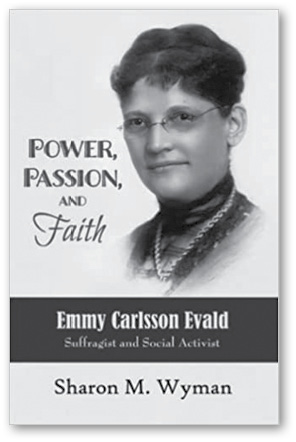Book Review: Power, Passion, and Faith
Power, Passion, and Faith: Emmy Carlsson Evald, Suffragist and Social Activist
Sharon M. Wyman
Saint Louis, Missouri: Open Books Press, 2022
Paperback, 211 pages

Emmy Carlsson Evald, suffragist, orator, church leader, mission-builder, tore through her eight-decade-long life like a whirlwind — and changed the world. She was a Swedish-American icon. She was a beloved and feared activist. But above all, she was a woman of faith, called, as she believed, to create a better tomorrow.
The title of Sharon M. Wyman’s engaging biography succinctly defines the qualities that shaped Evald: power, passion, and faith. Daughter of Reverend Erland Carlsson, Swedish immigrant who later helped found Augustana College and Theological Seminary, Emmy Carlsson grew up in Chicago’s Immanuel Lutheran Church. As a child she assisted her parents’ ministries to newly-arrived fellow countrymen. Though she married a prominent clergyman, Carl Evald, she remained emphatically her own person. Her early education in Sweden introduced her to universal suffrage; her years at Rockford Female Seminary (now Rockford University) established lifelong friendships with Jane Addams and other proto-feminists. She delivered compelling pro-suffragist speeches to state and national legislatures. But her master stroke was to parlay this passion for social equity into the church by creating the Woman’s Missionary Society. So potent were her achievements that she was designated one of the most influential women in Swedish America.
With a style as clear, straightforward, and energetic as Emmy Evald herself, Wyman traces this remarkable life. Her work is uniquely valuable: as Evald’s great-granddaughter she draws on family papers and personal recollections unavailable to other researchers. Glimpses of the private Emmy — comforting mother, playful grandmother, accomplished cook — surprise and delight. Wyman situates this material in its historical, cultural, and social contexts through concise explanation and vivid detail.
One area of background deserves fuller treatment, however: the influence of the Augustana Synod and its educational institution. Evald was embedded in this milieu through intergenerational connections; her father, husband, and son-in-law all served as Augustana pastors. Augustana’s distinctive theology and ethos shaped her faith, and that faith drove her political activism. A clearer explanation of its core tenets would help illuminate her sources of inspiration and strength.
That inspiration was unflagging, that strength uncompromising. As Wyman shows, Emmy was fearless. At nearly 70, for example, she beat off a Chinese robber with her bare fists, and lay immobile on an Indian cot for a whole day when a deadly viper slithered in beside her — until it slithered off. With similar courage she faced opposition from male-dominated political and ecclesiastical institutions. Though her signal triumph, mobilizing church women to create the Woman’s Missionary Society, initially garnered praise in clerical circles, it ultimately became the victim of its own success. Raising more than $3 million in four decades for educational, medical, and Christian mission work, it sought and was granted independence from church control. This power alarmed some synodical leaders. As sole president and WMS driving force for 43 years, Evald was seen increasingly as more of a threat than asset. Conflicts arose not just with the church but within the WMS itself. In dramatic and sometimes heart-breaking detail Wyman narrates this story of what she aptly calls “triumph and turbulence.”
Wyman’s attitude to her remarkable great-grandmother is understandably sympathetic, yet her admiration at times overrides objectivity. Attributing the “turbulence” mainly to sexism and fiscal disagreements oversimplifies conflicts in which personalities and principles were also interwoven. How much did Evald’s impatience of opposition and her aggressive self-assurance contribute to or fail to defuse the tensions?
Similarly, a more nuanced view of Evald’s mission projects, one that disentangles her “conversion” agenda from her social equity concerns, would give a clearer view of her best achievements. While rightly lauding Evald’s commitment to medical, educational, and social advancements, Wyman does not explicitly question Emmy’s goal of supplanting other faiths or philosophies with Christianity, or of introducing Western customs to Eastern cultures. Some treatment of Evald within the 19- and early 20th century colonial contexts in which Lutheran global missions were situated would have been warranted.
That said, overall the book is an admirable historical narrative. It’s a page-turning read for anyone interested in the Augustana Lutheran Church and in one of its most colorful movers and shakers. And it’s a valuable contribution to the growing field of women’s and feminist studies.
